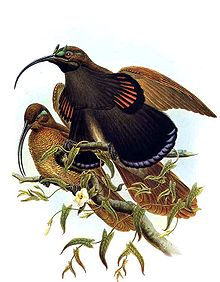- Black-billed Sicklebill
-
Black-billed Sicklebill 
Conservation status Scientific classification Kingdom: Animalia Phylum: Chordata Class: Aves Order: Passeriformes Family: Paradisaeidae Genus: Drepanornis Species: D. albertisi Binomial name Drepanornis albertisi
(Sclater, 1873)Synonyms Epimachus albertisi
The Black-billed Sicklebill (Drepanornis albertisi), also known as Buff-tailed Sicklebill (leading to easy confusion with the hermit hummingbird Eutoxeres condamini), is a medium-sized, about 35 cm long, brown bird of paradise. The male has a bare maroon grey skin around its eye, buff colored tail, dark brown iris, yellow mouth and black sickle-like bill. It is adorned with dark horn-like forecrown feathers, an erectile fan-like bronze neck plumes and elongated purple-tipped flank plumes. Unadorned brown female is smaller with bill longer than male and dark barred below.
The Black-billed Sicklebill is distributed to mountain forests of New Guinea. Its diet consists mainly of fruit and arthropods. The female lays one to two pale cream eggs with brown and grey spots.
The scientific name commemorates the Italian naturalist Luigi Maria d'Albertis, who discovered this species in 1872.
Widespread throughout its large range, the Black-billed Sicklebill is evaluated as Least Concern on the IUCN Red List of Threatened Species. It is listed on Appendix II of CITES.
References
- BirdLife International (2004). Epimachus albertisi. 2006. IUCN Red List of Threatened Species. IUCN 2006. www.iucnredlist.org. Retrieved on 29 October 2006. Database entry includes justification for why this species is of least concern
External links
Birds-of-paradise (family: Paradisaeidae) Genera and species LycocoraxParadise-crowArfak Astrapia • Splendid Astrapia • Ribbon-tailed Astrapia • Princess Stephanie's Astrapia • Huon AstrapiaWestern Parotia • Queen Carola's Parotia • Bronze Parotia • Lawes's Parotia • Eastern Parotia • Wahnes's ParotiaPteridophoraKing of Saxony Bird-of-paradiseLophorinaSuperb Bird-of-paradiseBlack-billed Sicklebill • Pale-billed SicklebillSemiopteraStandardwingSeleucidisTwelve-wired Bird-of-paradiseLesser Bird-of-paradise • Greater Bird-of-paradise • Raggiana Bird-of-paradise • Goldie's Bird-of-paradise • Red Bird-of-paradise • Emperor Bird-of-paradise • Blue Bird-of-paradiseIncomplete list of likely hybrids Astrapian Sicklebill • Barnes' Astrapia • Bensbach's Bird of Paradise • Blood's Bird of Paradise • Duivenbode's Bird of Paradise • Duivenbode's Riflebird • Duivenbode's Six-wired Bird of Paradise • Elliot's Bird of Paradise • False-lobed Astrapia • Gilliard's Bird of Paradise • King of Holland's Bird of Paradise • Lupton's Bird of Paradise • Lyre-tailed King Bird of Paradise • Mantou's Riflebird • Maria's Bird of Paradise • Mysterious Bird of Bobairo • Rothschild's Bird of Paradise • Rothschild's Lobe-billed Bird of Paradise • Ruys' Bird of Paradise • Schodde's Bird of Paradise • Sharpe's Lobe-billed Parotia • Stresemann's Bird of Paradise • Wilhelmina's Bird of Paradise • Wonderful Bird of ParadiseThis Paradisaeidae-related article is a stub. You can help Wikipedia by expanding it.

